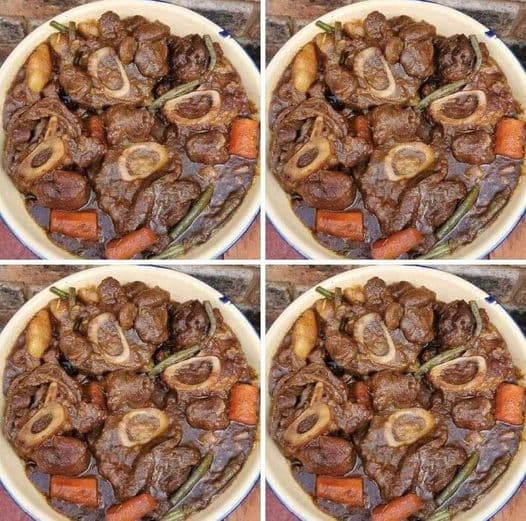For the Stew:
-
- 2 pounds (900g) of stewing beef, cut into bite-sized pieces
- 4 large potatoes, peeled and diced
- 3 carrots, peeled and sliced
- 2 onions, chopped
- 2 cloves of garlic, minced
- 2 tablespoons of vegetable oil
- 4 cups (960ml) of beef broth
- 1 cup (240ml) of stout beer (optional)
- 2 bay leaves
- 1 teaspoon of dried thyme
- Salt and black pepper to taste
- Chopped fresh parsley for garnish
Instructions Authentic Traditional Irish Beef Stew Recipe :
-
- Prepare the Beef: In a large, heavy-bottomed pot, heat the vegetable oil over medium-high heat. Add the beef chunks and brown them on all sides to develop rich flavor and color. Remove the beef from the pot and set it aside.
- Sauté the Aromatics: In the same pot, add the chopped onions and garlic. Sauté until they become translucent and aromatic, usually about 3-4 minutes.
- Add Back the Beef: Return the browned beef to the pot with the sautéed onions and garlic.
- Pour in the Liquids: Add the stout beer (if using) and beef broth to the pot. These liquids will create a flavorful base for the stew. Stir well.
- Season and Simmer: Season the mixture with dried thyme, bay leaves, salt, and black pepper. Stir everything together, cover the pot, and reduce the heat to a gentle simmer. Let it cook for about 1.5 to 2 hours, or until the beef becomes tender and easily falls apart.
- Add Vegetables: After the beef has simmered, add the diced potatoes and sliced carrots to the pot. These hearty vegetables will soak up the delicious flavors of the stew. Continue to simmer for an additional 20-30 minutes or until the vegetables are fork-tender.
- Serve and Garnish: Once the stew is ready, remove the bay leaves, and discard them. Ladle the hot stew into bowls, garnish with freshly chopped parsley, and serve piping hot with crusty Irish soda bread or your favorite bread.
Our Traditional Irish Beef Stew recipe is a delightful journey into the heart of Irish cuisine. The combination of tender beef, root vegetables, and savory broth will warm your soul and satisfy your taste buds. Whether you’re celebrating St. Patrick’s Day or simply craving a hearty, comforting meal, this authentic Irish stew is the perfect choice. Enjoy a taste of Ireland’s rich culinary heritage right in your own kitchen!
The nutritional content of Traditional Irish Beef Stew can vary depending on the specific ingredients and portion sizes used in the recipe. However, I can provide you with a general idea of the typical nutritional values for a serving of Traditional Irish Beef Stew made with the ingredients mentioned in the previous recipe.
Please note that these values are approximate and can vary based on variations in ingredients and cooking methods:
Nutrition for One Serving (Approximately 1 cup or 240ml):
-
- Calories: 250-300 calories
- Protein: 20-25 grams
- Carbohydrates: 20-25 grams
- Dietary Fiber: 3-5 grams
- Sugars: 3-5 grams
- Fat: 8-10 grams
- Saturated Fat: 2-3 grams
- Cholesterol: 40-60 milligrams
- Sodium: 600-800 milligrams
- Potassium: 600-800 milligrams
- Vitamin A: 20-25% of the Daily Value (DV)
- Vitamin C: 15-20% of the DV
- Calcium: 2-4% of the DV
- Iron: 15-20% of the DV
These values are based on a stew that includes lean beef, potatoes, carrots, onions, and a moderate amount of vegetable oil or stout beer. The nutritional content can change based on factors like the type of beef used (lean or fatty cuts), the amount of oil or fat added, and the specific vegetables used.
It’s important to note that Traditional Irish Beef Stew is a hearty and satisfying dish, but it can be relatively high in calories and sodium due to the meat and broth. If you’re concerned about the nutritional content, you can make adjustments such as using leaner cuts of beef, reducing added fats, or using low-sodium broth to make the stew healthier without compromising its flavor. Additionally, serving smaller portions and balancing your meal with a side salad or vegetables can also help manage the overall nutritional intake.


